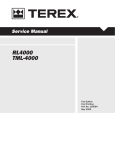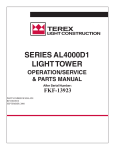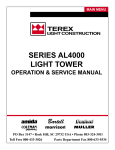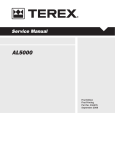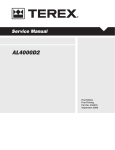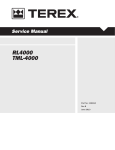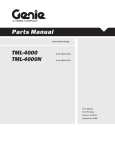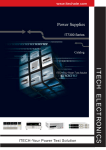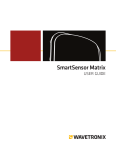Download AL4000 Australia models (PN AL4000AU)
Transcript
SERIES AL4000 AU LIGHT TOWER OPERATION & SERVICE MANUAL SERIAL NUMBER FOF-15872 AND LATER P/N - AL4000 AU REV. 19-02-2007 TABLE OF CONTENTS 1.0 2.0 Safety Precautions Page # Safety Precautions 4-8 Operating Instructions Light Tower Operating Instructions General Specifications and Routine Maintenance Recommended Engine Oil Fastener Torque Specifications Traceable Numbered Wiring System Criteria for Replacement of Wire Rope Broken Cable Replacement Procedure Cable Replacement Diagram Shim Placement Diagram Rear Bearing Inspection Requirements Engine (see manufacturer’s handbook) Generator (see manufacturer’s handbook) 3.0 Troubleshooting Guide Light Fixture Troubleshooting Guide Light Tower Troubleshooting Guide Engine (refer to manufacturer’s handbook) Generator (refer to manufacturer’s handbook) 4.0 9-16 17-18 19 20 21 22 23-24 25 26 27 n/a n/a 28-30 31-33 n/a n/a Wiring Diagrams Fixture with Joy Connector (MH) Metal Halide Ballast / 3-Pin Connector Wiring Diagram AC Wiring Trailer Wiring Coil Cord Wiring DC Wiring Control Box Wiring, Auto Shutdown Timer (continued next page) 2 36 37 38 39 40 41 42 5.0 6.0 Parts Manual Page # Decals Trailer and Related Part Fuel Tank Assembly Axle and Wheels Cabinet Assembly Tower Base Assembly – Electric Winch Tower Assembly Tower Section – Six inch diameter base tube Sheave and Shim Assembly - Four inch tower section Tower Section – Four inch square tube Tower Section – Three inch square tube Tower Section - Two inch square tube Crossarm Floodlight Fixtures Radiator Right Side Mounting Bracket Generator Mounting Engine and Generator (Kubota D1105 / Leroy Somer 8 kW) Radiator Assembly and Mounting Ballast Box Assembly – 50 Hz Electrical Box Assembly Auto Shutdown Timer 44 45 46 47 48-49 50 51 52 53 54 55 56 57 58 59 60 61-62 63 64 65 66 Warranty Information Terex Light Tower Model Coding System Manufacturer’s warranty statement 3 68 69 SECTION 1 SAFETY PRECAUTIONS The following symbols in this manual signal potentially dangerous conditions to the operator or equipment. Read this manual carefully. Know when unsafe conditions can exist. Then, take necessary steps to protect personnel, as well as equipment. WARNING: TEREX-Amida uses this symbol throughout this manual to warn of possible injury including death. CAUTION: TEREX-Amida uses this symbol to point out potential damage to equipment. Lamps, fuels, electrical equipment, batteries, exhaust gases, loose fasteners, and moving parts present potential hazards that could result in serious personal injury. Be diligent in following the procedures recommended below. Also, observe the many additional general safety rules practiced by trained operation and maintenance personnel in your company and industry. WARNING: Always wear a hard hat when operating the light tower! • Guard Against Electric Shock This light tower also has provisions for producing high voltage electricity that can produce a fatal shock to a person who accidentally places their self in the electrical circuit. Use every precaution to avoid contact with the high voltage electric circuit. Beware of a cut or damaged power cord. Replace immediately. Take extra precautions when troubleshooting electrical problems: When troubleshooting indicates a malfunction in the high voltage AC system, pass the troubleshooting task on to a qualified and trained electrician. Disconnect electrical power and turn off engine before removing protective covers on high voltage electrical enclosures. Understand that the electrical circuits in this light tower complete their paths back to the generator within the equipment. The neutral conductor at the generator is bonded to the equipment frame. Earth (ground) wires within the system are also bonded to the equipment frame. 4 • Guard Against Electric Shock (Power Lines) Ensure protection against overhead high voltage power lines. This light tower is not insulated. Any contact with high voltage power lines will result in death or serious injury. See diagram below for recommended clearances from overhead aerial conductors. Note: The specified clearances are recommendations. It is the responsibility of the person in charge to comply with the applicable regulations in force in the State in which the equipment is being operated. 5 • Guard Against Battery Hazards WARNING: Lead acid batteries can be dangerous. The sulfuric acid in the battery can cause severe skin and eye burns. The hydrogen gas emitted during charging can explode if an arc or flame is present near the battery. Use precautions to prevent acid burns or explosive conditions. Do not smoke while servicing batteries. Do not allow tools to touch battery terminals and create an arc. Do not test battery voltage by setting a brief arc at the terminals, use a multimeter instead. Disconnect the negative terminal of the battery when working on the engine or other parts to prevent accidental arcing. Disconnect the negative cable at the end away from the battery. Always wear eye protection when servicing the battery. When charging the battery, do not remove the vent caps. If acid does get on skin or in eyes, immediately flush under running water, and then obtain medical help as soon as possible. • Guard Against Fire Hazard Use caution with diesel fuel and motor oil because of fire hazards. Do not fill fuel tank while engine is running. Do not smoke or use open flame near the unit or the fuel tank. Be sure the fuel supply has a positive shut-off valve. Do not replace fuel lines with materials different from those supplied as original equipment. Have a fire extinguisher nearby. Be sure the extinguisher is properly maintained and be familiar with its proper use. Extinguishers rated ABE by the FPAA are appropriate for all applications. Keep this unit clean of excessive build-up of spilled oil and fuel. Accumulated oil and fuel can cause overheating and subsequent engine damage as well as present a fire hazard. • Protect The Environment And Practice Good Industrial Hygiene WARNING : DO NOT USE INDOORS UNLESS PROPERLY VENTILATED OR AN EXHAUST SCRUBBER IS USED. EXHAUST GASES ARE TOXIC. Provide an adequate exhaust system to properly expel discharged gases. Check exhaust system regularly for leaks. Periodically check to ensure that the exhaust manifolds are secure and not warped (see maintenance schedule in manufacturers handbook). Make sure the unit is well ventilated. Prevent pollution by catching used oil in a container for proper disposal. Wash hands to remove oil and fuel. Practice good industrial hygiene. 6 • Do Not Touch Hot Parts WARNING : The exhaust manifold and tailpipe are very hot. Parts of the engine are also hot. Avoid touching hot parts of the engine or tailpipe. Use protective gloves when handling hot parts Take note of CAUTION: Hot Surface decal adjacent to exhaust tailpipe. • Be Alert And Attentive To The Task Read the safety instructions and operating procedures before attempting to troubleshoot or work on this unit. Also read the engine and generator manuals, which are separate booklets that are provided with this manual. Do not work on this equipment when mentally or physically fatigued. Do not work on or operate this equipment when under the influence of performance impairing drugs or alcohol. If this manual becomes lost, order a new one from Genie Australia so future operation and maintenance personnel may read these instructions. • Beware Of Moving Parts Avoid being hit or pinched by moving parts of this unit WARNING: Loose jackets, shirts, sleeves and especially neckties should not be worn while working on or running the unit. Serious injury or death may result. Only remove guards or protective devices from unit temporarily to gain access for maintenance. Always replace guards and protective devices promptly. Keep your hands away from moving parts. Particularly, be sure to keep hands clear of the blower and alternator belts when the engine is running. Take note of WARNING: Entanglement Hazard decal on kerbside and roadside doors. • Beware Of Traffic Hazards Stand clear of traffic when starting or checking the unit along the road. Implement a traffic management system before setting up the unit. Check the fuel tank, oil pan, and fuel and oil lines for leaks that would spill fuel or oil on the road. Check fasteners and mounting brackets periodically to ensure all are tight and nothing is in danger of falling off during transit. • Be Careful When Lifting Use the lifting eye or forklift pockets on the tower for lifting the trailer and tower assembly only. Make sure any tie-downs at the bottom of the trailer are released, and the cradle retaining pin is inserted and secured, prior to lifting. WARNING: NEVER suspend any other equipment from the shipping tie-downs. Serious injury or damage to equipment may result. 7 • Use Only Equal Replacement Parts When a part fails and needs to be replaced only use equivalent parts of equal performance and strength. When a bolt is lost or fails, replace only with the equivalent size, length, thread, grade, and material. Replace stainless steel fasteners with stainless steel fasteners. The engine may use metric or SAE bolts, but all other bolts are generally SAE thread. Be sure to use Grade 8 bolts and nuts to mount the genset to the trailer. If the material/ grade of a fastener is in question, contact Genie Australia for information or part replacement. Replace the fuel and oil hoses with items of equal material, diameter and length. The wire rope must only be replaced with the genuine Terex part. Contact Genie Australia regarding replacement parts. • Use Caution Working Near Lamps WARNING : This unit is equipped with metal halide lamps. Metal halide lamps produce short-wave ultra-violet radiation and can cause serious skin and eye burns/ inflammation if the outer envelope of the lamp is broken or punctured. Do not operate this unit near people if the outer envelope of the halide lamp is broken. • Never Climb On Top Of Unit WARNING: NEVER climb on top of the cabinet and/ or tower when erected or retracted. Serious injury or death may result. • Never Carry Additional Items or Equipment WARNING: The trailer is not intended to carry any additional items or equipment. The light tower is not intended to carry any additional equipment such as banners or signs. Risk of overturning or overload. • Site Specific Hazards WARNING: Be mindful of the particular risks that may arise in certain locations. It is the end users responsibility to identify the hazards associated with setting up the light tower and to control those risks. Additional precautions may be necessary for example to isolate the public from the tower if it is left unsupervised in public spaces. In particular the unit should be secured to protect against vandalism or unauthorised entry into or onto the unit. • Check Safety Systems Have Not Been Tampered With WARNING: Be aware of injuries arising from tampering with safety systems. It is the users responsibility to ensure safety systems are functional before use. 8 SECTION 2 OPERATING INSTRUCTIONS IMPORTANT: READ ALL DIRECTIONS IN MANUAL CAREFULLY BEFORE OPERATING EQUIPMENT WARNING: DO NOT RAISE TOWER IN THE VICINITY OF OVERHEAD POWER LINES! ALWAYS WEAR A HARD HAT WHEN OPERATING MACHINERY! O PE RATI N G I N STR U CTI O N S In addition to the standard model light tower, a mine spec. variation is available which can be identified by the following additions: • Drip trays under fuel tank and engine sump • Louvred vents in engine enclosure doors • Mast tiedown chains • Flexible conduit installed on light fixture cables • Battery isolation switch • Auxiliary power outlet deleted • Residual current device (RCD) installed in generator output circuit Where appropriate, differences in operating instructions and parts information for each model are highlighted. I. MOVE LIGHT TOWER TO DESIRED LOCATION KEEPING THE FOLLOWING IN MIND: NOTE: Although the light tower is designed to withstand the rigors of the environment it can only do so if it is properly set up and monitored to ensure that it remains set up according to the specification. A. Beware, particularly during inclement weather conditions, of the following: • Wind conditions, maximum wind speed 100 km/h - risk of overturning • Subsidence under stabilising pads or the trailer in general - risk of overturning • Proximity to vehicular traffic - risk of collision • Proximity to power lines - risk of electrocution • When left in public places - risk of vandalism or theft • In winter environments risk of structural or mechanical damage • It is recommended that a contact phone number is displayed on the unit. 9 B. The light tower should not be placed where those working under the light are either: 1) Forced to look into the light regularly. 2) Forced to work with their backs to the light (shadows will block the light from the work area). C. The area where the tower is positioned should be firm and relatively level. The trailer must be set up within the range indicated on the level gauge provided on the drawbar. D. The light tower should be located on the same level or on ground higher than the area being lighted (higher light mounting heights reduce shadow length). E. Unit should be level to ensure smooth, trouble-free tower telescoping. Tower may not telescope down properly when unit is not level. II. UNHITCH FROM THE TOWING VEHICLE AS FOLLOWS: A. CAUTION: Ensure manual park brake is applied before unhitching from vehicle. B. Swing the jockey wheel into position and crank jack up to lift tongue off the towing vehicle. III. LEVEL THE TRAILER, USING THE JACKS AS FOLLOWS: A. Extend the front and rear outriggers until the lock pins snap into place. Swing the jack on each outrigger into vertical position and lock into place. Use dunnage under the pad if the ground surface is soft. B. Start at the highest jack position. Rotate the jack handle until the jack foot touches the ground. C. Raise the other jacks to level trailer. Use the level gauge provided on the drawbar to ensure the trailer is level. Ensure that all jacks are down to prevent the tower from tipping over when raised. WARNING: IV. A. NEVER use the jacks to raise tires off ground! DRIVE GROUNDING ROD INTO EARTH A grounding rod is provided. Please refer to local authorities for use of grounding rods. Drive the rod a minimum of 1.2 meters into the ground and secure the earth wire to the lug located on the trailer frame. 10 V. INSTALL THE FLOODLIGHTS ON THE CROSSARM (MINE SPEC. EXCLUDED) A. Remove the light fixtures from their travel position and install them on the crossarm studs. Fixtures should be mounted on the crossarm so that the plugs are closest to the mast. Ensure all fixtures are rotated down, and that adjacent fixtures face each other to minimize possible damage during transportation. B. Route the cords so that they do not interfere with rotating or tilting the light fixtures. C. Set the vertical aim for each light fixture. D. Set the spread between the light fixtures horizontal axis. E. Plug each fixture into the receptacles provided. If they are plugged into the numbered receptacles in a clockwise rotation, starting at upper or 1:00 position, it will be easy to troubleshoot the electrical system without lowering the tower (see diagram under Light Fixture Trouble-Shooting). CAUTION: If Tungsten Halogen lamps are used, the cord must be routed through the cord support rings. Failure to do so may result cord burn-through and short circuit due to the high fixture temperature. "T" BOLT FIXTURE STORAGE BRACKETS TRAVEL LOCKING PIN PIVOT PIN TELESCOPING LOCKING PIN KICK-OUT SPRING VERTICAL LOCKING PIN 11 VI. RAISING THE TOWER (refer to drawing on the previous page) A. MINE SPEC. ONLY: Disconnect the two (2) mast tiedown chains from the crossarm. B. Remove the tower travel locking pin from the cradle at the rear of the cabinet. Failure to remove the tower travel locking pin may cause winch overload. C. Aim the fixture, both horizontally and vertically, to the estimated angles that will light the work area. CAUTION: Ensure that the safety locking pin is removed from the vertical locking pin at the base of the pivot post prior to raising the tower. D. Activate the electric winch by pressing the winch toggle switch in the control box in the up direction this will raise the tower to the vertical position. The vertical locking pin at the base of the pivot post will lock automatically and you will hear it “snap” into place. Manually insert the safety locking pin into the locking device and secure with the attached hairpin clip. E. Release the tension on the cable by pressing the winch toggle switch in the control box to the down direction (loosen cable approximately ¼ - ½ turn). Pull the telescoping locking pin on the galvanized tower section. Hold this out while pressing the electric winch toggle switch in the up direction to raise the tower. After the tower has telescoped slightly, the locking pin can be released. Raise the tower to the desired height. Stop when the red paint is visible on the 75mm (3 inch) middle section. CAUTION: Do not over extend the light tower beyond the lower red mark on the middle mast section. WARNING: DO NOT ATTEMPT TO LEAN THE TOWER DOWN WHEN EXTENDED - DEATH, SERIOUS INJURY OR DAMAGE MAY OCCUR. VII. STARTING THE ENGINE / GENERATOR SET CAUTION: Ensure the circuit breakers are turned “OFF”. This prevents the engine from starting under load and prevents electrical equipment from being damaged due to improper voltage and frequency. A. If the engine was previously shutdown by the auto shutdown timer elapsing (see Section XV), the RESET button must be depressed before the engine can be re-started. B. Check the oil, fuel, and coolant levels. If the fuel tank is empty, it may be necessary to bleed the fuel line after filling the tank (see engine instruction book for procedure). C. Turn the ignition switch to the “ACC” position (see adjacent diagram). Press the preheat push-button for a maximum of 20 SECONDS. Do not engage the preheat button longer than the time specified or damage may occur. 12 D. Turn the ignition switch to the “START” position to engage the engine. After the engine starts, release the switch so that it returns to the “RUN” position. Let the engine come up to speed and stabilize (review the engine operating procedures in the manufacturers handbook). Note: If engine will not start, leave switch in run position for additional 15-20 seconds (maximum of 45 seconds) to completely prime the fuel system. Then repeat step “D” and start engine. VIII. TURN ON THE FLOODLIGHTS A. Turn on the main circuit breaker. Turn the circuit breakers “ON” and check to ensure all lamps come on. Allow a minimum of two (2) minutes for lamps to reach full luminance. B. If required, rotate the tower to aim the lights as desired. Tighten the tower rotation T-bolt. C. Adjust the tower vertically and adjust lighting direction of individual fixtures if required. IX. TURN OFF FLOODLIGHTS A. Turn light circuit breakers off. Turn main breaker off. B. Allow the engine to run approximately 30 seconds after load has been removed prior to turning off the engine. C. Turn engine switch to “OFF” to shut down the engine. CAUTION: Do not shut down engine prior to turning lights off. CAUTION: Allow lamps to cool at least ten to fifteen (10-15) minutes before moving the tower to avoid lens or bulb breakage. X. LOWERING THE TOWER TO TRAVELING POSITION A. Using the electric winch, telescope the tower down to its fully retracted position until the telescoping locking pin snaps into place. CAUTION: Ensure that the telescoping locking pin locks before pulling the vertical locking pin at the base of the pivot post. This ensures the tower is completely lowered and cannot be damaged by telescoping out while in the travel position. B. Loosen the tower rotation T-bolt. C. Rotate the tower so that the groove in the galvanised ring at the pivot is pointing to the rear of the trailer to enable the tower to be lowered into the travel position. D. Tighten the tower rotation T-bolt. CAUTION: Ensure that personnel are not in close vicinity to the tower, particularly behind the trailer when the tower is being lowered. 13 E. Pull the vertical locking pin at the base of the pivot post (the kick-out spring should provide sufficient pressure to start the tower pivoting over when the electric winch toggle switch is pressed in the down direction). F. Continue to lower the tower into the cradle using the electric winch. G. Insert the tower travel locking pin into the cradle. Secure with hairpin clip. XI. RELOCATING LIGHT TOWER TO NEW LOCATION A. Ensure that tower has been properly lowered (see Section X) and all locking pins are engaged. B. Ensure all fixtures are rotated down, and that adjacent fixtures face each other to minimize possible damage during transportation. C. MINE SPEC. ONLY: Attach the two (2) mast tiedown chains to the crossarm and tension using the turnbuckle. CAUTION: Ensure manual park brake is engaged before retracting outriggers. D. All jacks must be raised, swivelled up and all outriggers locked into travel position. Disconnect the earth rod and lead and place in the storage provided inside the trailer. E. Ensure that the tow coupling is properly secured to the towing vehicle and safety chains are attached. Raise the jockey wheel and rotate and lock in position. Release the manual park brake. F. Do not tow at excessive speeds (100 km/h or 60 mph maximum) as the weight of the light tower can cause loss of vehicle control, especially under emergency conditions. XII. AUXILIARY POWER OUTLET (MINE SPEC. EXCLUDED) A. Total auxiliary power cannot exceed 2500 W. A 10 Amp residual current device (RCD) is installed in the auxiliary power outlet circuit. B. Before plugging in extensions cords, feed them up through the trailer frame and connect to the outlet. Close the cabinet doors to protect control panel and other components from weather (see Miscellaneous Specifications and Routine Maintenance section for power control details). C. Ensure that all extension cords are protected from damage and water. D. The operator must test the RCD using the test button daily, or before every use, whichever is the longer. Ensure that the RCD is on, then push the test button and check that it trips. 14 XIII. GENERATOR RESIDUAL CURRENT DEVICE (MINE SPEC. ONLY) A. A 20 Amp residual current device (RCD) is installed in the generator output circuit. B. The operator must test the RCD using the test button daily, or before every use, whichever is the longer. Ensure that the RCD is on, then push the test button and check that it trips. XIV. LEAVING THE LIGHT TOWER UNATTENDED A. Before leaving the light tower unattended, secure all items and lock the cabinets to prevent unauthorised use. B. Be mindful that weather conditions may change and ensure that an emergency response procedure is in place. C. Arrange for periodic inspections where necessary. D. Protect the light tower against vandalism and wilful damage by securing the tower and locating it in a secure area. XV. AUTO SHUTDOWN TIMER (OPTION) An auto shutdown timer is available as an option for standard and mine spec. light towers. The timer will shutdown the engine after a preset run time so that the light tower may be left unattended (see Section XIV). A. The engine must first be running before the timer can be started. 15 B. To start timer, hold switch in START position until ON lamp illuminates (for about 3 sec.) C. Select desired run time using rotary switch (6-14 hours). D. The timer can be stopped before the preset run time has elapsed by toggling the switch to the STOP position (ON lamp switches off). E. After the preset run time has elapsed, the RESET button will trip and the engine will shutdown. F. The RESET button must be depressed before the engine can be re-started. CAUTION: Ensure the circuit breakers are turned “OFF” before re-starting the engine. This prevents the engine from starting under load and prevents electrical equipment from being damaged due to improper voltage and frequency. XVI. BATTERY ISOLATOR SWITCH (MINE SPEC. ONLY) A lockable battery isolator switch is provided to prevent unauthorised use of the light tower. 16 TEREX-AMIDA MODEL AL4000 AU LIGHT TOWER GENERAL SPECIFICATIONS AND ROUTINE MAINTENANCE TEREX-Amida Model AL4000 AU Series Light Tower provides mobile, trailer mounted floodlighting for night time maintenance, construction, mining, and emergency work. It consists of a trailer with diesel powered 8 kW 50 Hz 240 Volt generator, and a 30 foot cable actuated tower with four (4) 1000 watt floodlight fixtures. It is ideally suited for heavy-duty use and is built to meet the following specifications: SPECIFICATIONS Overall length, travel position w/fixtures & tongue ................... 4547 mm (179”) Overall length, tower vertical w/tongue & jacks ........................ 3150 mm (124”) Trailer frame length .................................................................... 1778 mm (70”) Overall height, floodlighting position ........................................ 9.14 m (30ft) Overall height, travel position .................................................... 1727 mm (68”) Overall width with fenders ......................................................... 1549 mm (61”) Overall width with outriggers pulled out .................................... 2591 mm (102”) Trailer frame width ..................................................................... 1041 mm (41”) Tongue length ............................................................................. 1333 mm (52.5”) Tongue weight w/lights on crossarm .......................................... 56.7 kg (125 lb) Wheel size .................................................................................. 381 mm (15”) Tyre pressure................................................................................ 220 kPa (32 psi) Axle Rating ................................................................................. 1587 kg (3500 lb) Total weight no fuel .................................................................... 1014 kg (2235 lb) Fuel Capacity .............................................................................. 114 L (30 gal) Unit weight with full fuel tank ................................................... 1109 kg (2445 lb) Maximum towing speed...............................................................100 km/h (60 MPH) Maximum wind speed..................................................................100 km/h (60 MPH) Beaufort scale - 10 (whole gail) Noise Level ................................................................................. 62 dBA @ 7 m Electric Winch ............................................................................ 12 V 1800 kg (4000 lb) Auxiliary Power Outlet (Mine Spec. Excluded) ......................... 10 A, 240 V 50 Hz, 2500 W 17 BRAKE SYSTEM This light tower is fitted with hydraulic surge brakes and a manual park brake. - Hydraulic brake system requires DOT3 or higher brake fluid - Service interval for brake adjustment every 200 hours. ELECTRIC WINCH CAUTION: The winch wire rope must be inspected periodically according to the instructions on page 22. The wire rope must only be replaced with the genuine Terex part. WARNING: Never stand under any object lifted by a winch. The electric winch is permanently sealed and does not need any periodic lubrication. The electric winch must only be replaced with the genuine Terex part. AUXILIARY POWER OUTLET (MINE SPEC. EXCLUDED) A competent person must test the RCD according to AS/NZS 3760 every 12 months. GENERATOR RESIDUAL CURRENT DEVICE (MINE SPEC. ONLY) A competent person must test the RCD according to AS/NZS 3760 every 12 months. TRAILER Periodically check the condition of the trailer including the fuel tank, lighting and structure. NOISE LEVEL Mean SPL (sound pressure level) hemispherically at 7 meters:..................62.01 dBA Sound Power Level:.....................................................................................90.0 LWA re 1 pW WIND SPEED RATING The AL4000 AU light tower has a wind speed rating of 100 km/h (Beaufort Scale 10). The light tower must be set up as per the operating instructions in this manual to achieve the maximum wind speed rating of 100km/h in any direction. STATUTORY APPROVALS The Terex AL4000 AU light tower is built to the following standards: - AS 2790 Electricity generating sets - Transportable - AS 3010 Electricity installations - Generating sets - AS 3713 Acoustics - Industrial trucks - Noise measurement - AS 1170.2 Structural design actions - Wind actions 18 OIL/AIR SERVICE Change the engine oil after the first 50 hours of use, and then every 200 hours thereafter. Replace the oil filter at 250 hours (2nd oil change) and after every 400 hours of use thereafter. The air filter element should be replaced once every year, or after six cleanings (see manufacturer’s operation manual for details). RECOMMENDED ENGINE OIL & FUEL KUBOTA D1105 DIESEL ENGINE Engine oil should be MIL-L-2104C or have properties of API classification of CD grades or higher. Change the type of engine oil according to the ambient operating temperature: Above 25°C (77°F) 0 to 25°C (32°F to 77°F) Below 0°C (32°F) SAE 30 SAE 20 SAE 10W SAE 10W-30 Use #2 diesel fuel. NOTES: 1. The temperatures in the table are the ambient temperatures at the time when the engine is started. If the running ambient temperatures are much higher than the starting temperatures, a compromise must be struck and a higher viscosity oil used. Multi-grade oils overcome the problem, provided they possess a suitable specification. 2. MIL-L-2104B or MIL-L-2104C or API CD must also be used if the sulfur content of the fuel exceeds 0.5%. 3. Always use a reputable brand of diesel fuel. The sulfur content should be below 0.5% (higher sulfur content would require more frequent oil changes). Observe strict cleanliness when filling the fuel tank. 4. Check the engine oil level before starting the engine or more than five minutes after it has been stopped. Remove the dipstick, wipe clean, reinsert it, take it out again, and check the oil level. If the oil level is too low, remove the oil filler cap and add new oil until the FULL line on the dipstick is reached. 19 FASTENER TORQUE SPECIFICATIONS All fasteners should be torqued to the following specifications in ft-lb (Nm). These are average values and a +/- 5% tolerance is acceptable. FASTENER STAINLESS STAINLESS STEEL* STEEL* SIZE NYLOC UNF NUT & UNC #6 #8 #10 1/4" 5/16" 3/8" 7/16" 1/2" 9/16" 5/8" 3/4" 4 mm 6 mm 8 mm 10 mm 12 mm 16 mm 18 mm 20 mm .92 (1.24) 1.8 (2.4) 2.43 (3.3) 7.1 (9.5) 11 (15) 21 (28.5) 32 (43.4) 44 (60) 60 (81) 99 (133) 132 (179) 2.0 (2.7) 4.0 (5.4) 1.0 (1.4) 19 (25.7) 43 (58) .75 (1.0) 1.5 (2.1) 2.1 (2.8) 6.0 (8.1) 13 (17.6) 23 (31.2) 33.5 (45.4) 47 (64) 63 (85) 102 (138) 145 (197) 1.8 (2.4) 3.4 (4.6) 10 (13.6) 16 (21.7) 37 (50) SAE GRADE 5 PLATED (METRIC 8.8) 1.3 (1.7) 2.2 (3.0) 3.5 (4.8) 8.0 (11.0) 16 (21.6) 31 (42) 42.5 (57.6) 80 (108) 90 (122) 150 (203) 230 (312) 2.1 (2.8) 6.3 (8.5) 15 (20.3) 48 (65) 58 (79) 144 (195) 193 (262) 285 (386) SAE GRADE 5 PLATED NYLOC NUT SAE GRADE 8 PLATED (METRIC 10.9) SAE GRADE 8 PLATED NYLOC NUT 75 (102) 85 (115) 145 (197) 215 (292) 13 (17.6) 25 (34) 47.5 (64.4) 72 (97) 105 (142) 153 (207) 190 (258) 400 (542) 100 (135) 142 (193) 180 (244) 385 (522) 43 (58) 53 (72) 73 (99) 100 (135) * An anti-seize lubricant MUST be used on all stainless steel hardware. 20 TRACEABLE NUMBERED WIRING SYSTEM (Using plug in ballasts to troubleshoot) When troubleshooting the proceeding problems, minimize down time by following the traceable numbered wiring system, always follow these steps: STEP1: Ensure all ballasts, which are numbered, are plugged into lead wires with corresponding numbers. STEP 2: Looking at the lights from the glass side and following the diagram below, plug each fixture into the appropriately numbered plug at the top of the tower. WARNING: Ensure that the engine is not running and that the breakers are turned off when connecting and disconnecting the light fixtures and ballast cables. By adhering to the traceable numbered wiring system, troubleshooting, fixture aiming, and fixture control will follow a standard predictable pattern. 21 CRITERIA FOR REPLACEMENT OF WIRE ROPE – TEREX-AMIDA LIGHT TOWERS The wire ropes used to raise and lower the masts on a TEREX-Amida Light Tower are probably some of the most important mechanical parts used in day-to-day operation of the machinery. It is therefore very important that the cables be inspected on a frequent basis (once a month) for wear and tear, and immediately in the event of possible damage due to operator error in using the winch, or possible damage from other equipment. NORMAL WEAR AND TEAR When used properly, the wire ropes should give years of trouble-free service, depending on how often the masts are raised and lowered. The rule of thumb at TEREX-Amida is that if the tower is raised and lowered an average of once per day, that the cables should be replaced every two years of service. The wire rope must only be replaced with the genuine Terex part. NORMAL INSPECTION The wire ropes are constructed of 7 strands of 19 ply steel wires each twisted together, and then the assembly is galvanized to resist corrosion. Visually inspect the entire length of the cable, wear heavy leather gloves (to avoid being pricked by a broken wire). If any exterior wires are broken, they will lift up from main body of the cable and become visible. In any 300 mm length of rope; if there are 4 or more broken wires in 2 or more strands, the rope should be replaced immediately. The wire rope must only be replaced with the genuine Terex part. OPERATOR ERROR – OTHER MACHINERY DAMAGE One of the most common reasons for failure of a Light Tower wire rope is due to operator error in using the winch, or damage to the cable by tools or other machinery. The most common error occurs if the winch is operated when the mast is fully retracted and the telescopic locking pin locked, but the vertical locking pin at the base of the pivot post is not pulled out so that the mast can be lowered into the cradle. This can result in three problems: the loose cable can get trapped underneath itself, resulting in a sudden or partial “drop” of the mast when the loose section releases at a later time, thus damaging the cable; or the cable can jump off the winch drum and be damaged by the gears of the winch. The loose cable can also cause the drum to spin to take up the slack cable. Other reasons damage can occur are due to some outside force such as forklift blade nicking or crushing a cable when moving a unit, or an accidental blow or damage by a hand tool, etc. DAMAGE INSPECTION If any nicks (partial strand cut through), kinks (permanent bends), or weld spatter on the cable (from field service) are observed, the wire rope should be changed immediately. The wire rope must only be replaced with the genuine Terex part. If there is a crushed spot somewhere on the wire rope, it should be replaced if the width of the crushed spot exceeds 1-1/4 times the nominal diameter of the cable (5/16” on a 1/4” cable, and 7/32” on a 3/16” cable), or if there are broken wires at the point of damage. 22 BROKEN CABLE REPLACEMENT PROCEDURE CAUTION: The wire rope must only be replaced with the genuine Terex part. This ensures the rope is replaced with the correct grade and rope construction and also a rope of sufficient length. 1. PREPARATION (refer to fig. 1 cable replacement diagram and fig.2 shim placement) 1.1 Collapse tower to where mast is retracted, then pivot tower to horizontal position. 1.2 Remove the fixtures and the power cord from the tower. 1.3 Remove the tower from the trailer and place it on a work surface such as two saw horses. Lower Cable .eshor 2. Telescoping Lock Sheave Brackets Large Section Rivets Clevis Pin Middle Section Small Section REMOVING TOP CABLE AND TOP MAST SECTION 2.1 Tie middle section and large section together by wrapping band, cable, chain, or rope around the sheave brackets on these two sections. This ensures that the middle section stays inside the large section during removal of the small section. 2.2 Remove or lock the telescope lock pin open. This is the pin that locks the three sections together during travel. 2.3 Drill out the pop rivets holding the plastic guides at the top of the middle section. Using a screwdriver, remove these guides. 2.4 Remove the clevis pin anchoring the cable to the top of the middle section and remove the clevis pin and the sheave from the middle section. 2.5 Pass the free end of the cable through the sheave slot between the middle and small section, and out of the top of the tower. Pull the cable and the small section completely out of the middle section together. Be sure to keep the cable tight; if slack accumulates it is most difficult to remove. 2.6 Unfasten the cable by removing the bolt at the base of the small section. 3. REINSTALLING THE SMALL SECTION 3.1 Fasten new cable to the base of the small section. 3.2 Reversing the procedure described in steps 2.1 through 2.5, reinstall the small section. 3.3 Reinstall the plastic guides with new pop rivets. New plastic guides should be used, but the old guides can be used if their mounting position is shifted to the point where new holes can be drilled in the tower section to provide a good fit when installing new pop rivets. 23 4. REMOVING THE LOWER CABLE AND MIDDLE TOWER SECTION 4.1 Remove or lock open the telescope lock pin if not previously done in step 2.2. 4.2 Drill out the pop rivets holding the plastic guides at the top of the large section. Using a screwdriver, remove these guides. 4.3 Remove the cable from the winch drum. 4.4 Remove the sheave clevis pin and the sheave from the top of the large section. 4.5 If the old cable is not frayed between the winch and the bottom mast pulley, attach a flexible “fish wire” or “snake” (wire, rope, cord, etc.) to the end of the cable to be used to thread the new cable through the lower tower and pulleys. This can be done by “untwisting” the cable and inserting the wire or cord into the middle of the cable and thus letting the cable twist back tightly around the fish wire. If the old cable is frayed, cut off the frayed portion and proceed as above and then remove tower and cable as instructed in section 4.6. Pass the free end of the cable through the sheave slot between the large and middle sections, and out of the top of the tower. Pull the cable and the middle section completely out of the large section together. Be sure to keep the cable tight – if slack accumulates it is most difficult to remove. 4.6 If the fish wire doesn’t work, it is necessary to remove the square mast section from the round mast section. Remove the pivot pin from the pivot post and lift the mast from the pivot post and place the mast assembly on a work surface. Remove the hex nut from the bottom of the round section, remove the “T” bolt at the top of the round section, and pull the square mast assembly out of the round section, and proceed as instructed in section 4.6. 4.7 Unfasten the cable by removing the bolt at the base of the middle section. 5. REINSTALLING THE LOWER CABLE AND MIDDLE SECTION 5.1 If the “fish wire” worked, attach the new cable to the fish wire and pull through the pulleys and the round section. 5.2 If the square tower section was removed from the round section, thread the cable through the pulleys at the bottom of the large section and out of the tubular stud. Reinstall the large square section into the round section, making sure the white plastic “doughnut” is placed on the threaded tube on the bottom of the large square section. Install the “T” locking bolt, and the hex nut on the bottom of the round section. The hex-locking nut should be tightened and then backed off approximately one-half turn or until the tower rotates freely. 5.3 Fasten the new cable to the base of the middle section. 5.4 Reversing the procedures detailed in sections 4.4 through 4.7, reinstall the middle section. 5.5 Fasten the new cable to the winch drum. 5.6 Reinstall the plastic shims as described in section 3.3. 24 AL4000 LIGHT TOWER Cable Replacement Diagram Figure 1 6" Round Tube 2" Section Cable 2 Point B 3" Section 4" Section "Hat" Section Cable 1 Point B Cable 2 Point A Cable 1 Point A Winch Tower Base 25 SHIM PLACEMENT Figure 2 183286 (5/16" thk) 185290 (3/8" thk) 3" TOWER SECTION 4" TOWER SECTION 177830 (1/4" thk) 177830 (1/4" thk) 177820 (5/16" thk) 177820 (5/16" thk) 2" TOWER SECTION 177820 (5/16" thk) 183288 (3/16" thk) SHIM PLACEMENT( as viewed from crossarm end) 26 Rear Bearing Inspection Requirements Leroy-Somer 6 & 8 kW Generators The rear bearing on all 6 & 8 kW generators should be inspected every two (2) years or 2000 hours, whichever occurs first. The bearing should be replaced at three (3) years or 3000 hours. Careful attention to this inspection procedure will prevent total generator failure resulting from bearing or bearing carrier deterioration. There are two areas to examine during the inspection. First is the clearance between the bearing outer case and the generator bearing carrier (NDE Bracket). The bearing should fit snugly into the carrier so that it can be rotated only with some resistance. Side to side movement should be less than .010". If the bearing can be moved easily inside the carrier or if there is visible evidence of bearing carrier wear, the housing carrier should be replaced with End Kit #836835 (which includes the carrier, bearing and 0-Ring). The second area of concern is the bearing itself. If roughness can be felt when rotating the outer race of the bearing, the bearing needs to be replaced (#836828). The other area to check is to see if the outer race will rock back and forth along the bearing axis. If there is movement in this axis, replace the bearing. If neither of these conditions exist, replace the bearing retaining 0-Ring (#836830) and reassemble. Note: These bearings are sealed units and cannot be field serviced. Follow the same procedure at three (3) years or 3000 hours. At this time replace both the bearing and O-Ring as well as inspecting the bearing carrier. 27 SECTION 3 LIGHT FIXTURE TROUBLESHOOTING GUIDE DANGER! Do not open fixtures while light circuit breaker is “ON”. Allow lamp to cool before touching. **TAKE EXTRA PRECAUTIONS WHEN TROUBLESHOOTING ELECTRICAL PROBLEMS** DANGER! NO USER SERVICEABLE PARTS INSIDE! THIS IS ONLY A GUIDE. UNIT TO BE SERVICED BY QUALIFIED ELECTRICIAN ONLY!!! A. B. C. D. E. Only use a voltmeter with two well-insulated pin probes rated for 600 V. Treat all conductors as potentially hot. Proceed through circuits systematically, operating only one section at a time. Before disconnecting ballast, turn off circuit breaker and wait 30 seconds for capacitor to discharge. If all the lights are out and all the ballasts are receiving power, suspect burned out tower power cable. SYMPTOM CAUSES CORRECTIVE ACTION LAMP WILL NOT START Lamp loose in socket Inspect lamp base to see if there is arcing at center contact button. Tighten lamp snugly. Check socket for damage. Replace if defective. Floodlight plugs not tight Check plug and receptacle. Tighten if loose. Defective ballast Interchange ballast plugs in generator enclosure. If lamp starts, replace ballast. Check ballast wiring diagram. Check for swollen capacitors, charred wiring, core and coil, or other signs of excessive heat. Low voltage Check line voltage at ballast input. Voltage should be within 10% of nameplate rating when operating at normal load. Increase supply voltage or remove external load. Improper ballast Proper HID lamps will perform erratically or fail to start on an improper ballast. The ballast name plate data should agree with the line voltage and lamp used. Improper ballast will cause lamp to fail. LAMP STARTS Lamp has been operating SLOWLY (ARC DOES NOT STRIKE WHEN SWITCH IS Defective lamp FIRST TURNED ON) MH lamps require from 4 to 8 minutes cool-down time before lamp is cool enough to restrike. Switch off breaker and allow lamp to cool. Lamp may glow for extended period of time. Replace after checking voltage and ballast. 28 LIGHT FIXTURE TROUBLESHOOTING GUIDE (CONTINUED) SYMPTOM CAUSES CORRECTIVE ACTION CIRCUIT BREAKER TRIPS ON LAMP STARTUP Short circuit or ground Check wiring against diagram. Check for shorts or ground. LAMP LIGHT OUTPUT LOW Normal lamp depreciation Replace lamp Dirty lamp or fixture Clean lamp and fixture Defective ballast Interchange ballast plugs in generator enclosure. If lamp returns to normal light output, replace ballast. Check for swollen capacitors, charred wiring, core and oil, or other signs of excessive heat. Wrong voltage Check voltage at ballast input. Voltage should be within 10% of nameplate rating. Check wiring connections for voltage loss. Check socket contact point. Improper ballast Check ballast nameplate against lamp data. Normal lamp depreciation Lamp color and brightness decreases and colors change slightly as lamps age. Spot replacement with new lamps may cause noticeable differences in lamp colors. Group replacement minimizes color differences. Dirty fixture Dirty fixtures will cause lamps to appear different in color. Clean fixture. Wrong lamp Check data on lamps which appear different in color. Replace with correct color lamp. Over voltage from power supply Check voltage at ballast. Check for current or voltage surges. Check for shorted capacitors and replace if defective. Improper ballast Lamp operated on ballast designed for higher wattage lamp. Check ballast nameplate against lamp data. Lamp damaged Check for outer bulb cracks. If air enters outer bulb, arc tube may continue to burn for 100 hours before failure. Check for bulb cracks where glass meets the base due to tightening lamp too firmly in socket. Look for broken arc tube or loose metal parts. Replace lamp. LAMP COLORS DIFFERENT ARC TUBE DISCOLORED OR SWOLLEN SHORT LAMP LIFE 29 LIGHT FIXTURE TROUBLESHOOTING GUIDE (CONTINUED) SYMPTOM CAUSES CORRECTIVE ACTION SHORT LAMP LIFE Improper ballast Ballast nameplate data should agree with lamp line voltage and lamp use. If improper ballast is used, the lamp life will be shortened. A mismatch may also cause the ballast to fail. LAMP FLICKERS AND GOES OUT INTERMITTENT OR CYCLING Improper ballast Improper ballasting can cause flickering or erratic operation. In the start-up period the lamp may ignite, start to warm-up and then extinguish (cycle). New lamp Under certain conditions new lamps may “cycle”. Usually after three (3) tries to start at 30 to 60 second intervals, lamps will stabilize and operate satisfactorily. Defective lamp Replace lamp High spike ballast Ballast produces high spike current. Measure with oscilloscope. Replace ballast as required. 30 LIGHT TOWER TROUBLESHOOTING GUIDE The engine and the generator are set at the factory. These units are tested and set to 1500 RPM at 50 Hz for proper operation in the field. These units should never require additional adjustments in the field. Adjustments should only be made by a qualified service technician, otherwise the manufacturer’s warranty may become void. SYMPTOM CAUSES CORRECTIVE ACTION TOWER WILL NOT RISE TO THE OPERATING POSITION Cradle pin is in place. Remove cradle pin. Defective cable or pulley. Have a trained mechanic examine and repair as needed. Defective winch. Have a trained mechanic inspect and replace the winch as needed. Defective winch. Have a trained mechanic inspect and replace the winch as needed. Broken cable or pulley. Have a trained mechanic inspect and replace the cable & pulley as needed. Dead battery/connection Check the battery voltage or for loose cables. The engine has seized Have a trained mechanic inspect and repair as needed. Empty fuel tank Fill tank with #2 diesel fuel Auto shutdown timer not reset Press RESET button on auto shutdown timer Clogged fuel lines or filter. Check and clean the fuel system as needed. Leaking fuel lines, or a loss of prime Replace any leaking fuel lines & tighten connections. Glow plugs burned out. Replace glow plugs. Fuel line solenoid is not open Replace fuel line solenoid. BOOM WILL NOT TELESCOPE ENGINE WILL NOT TURN OVER ENGINE TURNS OVER, BUT WLL NOT START 31 LIGHT TOWER TROUBLESHOOTING GUIDE (CONTINUED) SYMPTOM CAUSES CORRECTIVE ACTION ENGINE RUNS ROUGH Clogged or leaking fuel system. Replace fuel lines, tighten all connections. Inspect the pickup tube, and inspect the fuel filter. Clogged exhaust system. Clear the exhaust system. Clogged air filter. Replace the air filter. Clogged or stuck fuel Have a trained mechanic inspect the injectors. Valve clearances are out of adjustment, or the valve spring(s) may be damaged Have a trained mechanic inspect the valves. Defective governor Have a trained mechanic inspect the governor and injector pumps. ENGINE RUNS, BUT PRODUCES A DENSE SMOKE Crankcases oil level is too high Drain oil to its proper level. Low compression. Have a trained mechanic inspect for broken or seized rings. Also inspect the valve clearance. ENGINE OVERHEATS Blocked radiator air intake. Inspect the front and rear intakes and clean/clear as needed. LOW COOLANT LEVEL Heavy duty use/small leak. Replace the coolant with a 50% water/coolant solution. Radiator fins have become clogged. Clear the radiator fins. Fan belt is loose. Tighten fan belt. Alternator has failed. Have a trained mechanic inspect the alternator. ENGINE RUNS, BUT THE BATTERY VOLTAGE IS LOW 32 LIGHT TOWER TROUBLESHOOTING GUIDE (CONTINUED) SYMPTOM CAUSES CORRECTIVE ACTION ENGINE RUNS, BUT THE LIGHTS WILL NOT OPERATE Circuit breakers are tripped. Reset the circuit breaker. Loose connections in the wiring system. Have a trained electrician inspect the ballast box wiring system. BURNED OUT BULB Replace bulbs as needed. UNUSUAL NOISE COMING FROM THE GENERATOR Defective capacitor (Leroy Somer generator). Have a trained electrician inspect the capacitor. Defective AC generator. Have a trained electrician inspect the generator. Engine speed is too low. Have a trained mechanic inspect the engine speed and reset to 1500 RPM @ 50 Hz. The generator has a defective bearing or has a damaged fan blade. Have a trained electrician inspect the generator. WARNING: If you feel an electric shock at any time while operating this unit, SHUT IT DOWN IMMEDIATELY! Have the unit inspected by a trained electrician. This engine/generator set is factory installed, tested, and set for operation in the field. Any damage to the engine or generator units occurring after adjustments are made in the field by unauthorized personnel will not be covered by your manufacturer’s warranty and will also void the manufacturer’s warranty on this particular unit. If you can not reach your local dealer, contact the factory Service Manager TOLL FREE at 1800-331-660. 33 This Page Left Intentionally Blank 34 SECTION 4 WIRING DIAGRAMS 35 36 EUROPEAN COLOR CODE LIGHT BLUE BROWN GREEN W/YELLOW DOMESTIC COLOR CODE WHITE BLACK GREEN COMMON FROM BALLAST HOT FROM BALLAST (LIVE) GROUND (EARTH) CIRCUIT NOTE: PIN CONFIGURATION IS THE SAME FOR TUNGSTEN HALOGEN FIXTURES WHITE (BLUE) GREEN (GRN/YEL) BLACK (BROWN) 14/3 3/15/00 DATE ECO # DWG.# 2985A DESCRIPTION ADDED EUROPEAN (CE) WIRING DATA CHANGE #REQ 590 HUEY Rd, ROCK HILL, S.C. Ph. (803) 324-3011 FAX 366-1101 WIRING DIAGRAM, MH OR HPS FIXTURE REMOVE ALL BURRS & SHARP EDGES MATL. W/JOY CONNECTOR BORDER "B" SCALE MAT P/N NONE DR BY DWG.# 2985A PLOT 4/30/91 DATE 4/30/91 PART# WD2985 Fractions ±1/16 Decimals .XX=±.030 .XXX=±.010 .XXXX=±.005 Degrees ±1/2° TOLERANCES UNLESS OTHERWISE SPECIFIED: A REV. PART# WD2985 ITEM# PART# 37 GRN CIRCUIT INPUT 120V INPUT COMMON LAMP HOT LAMP COMMON GROUND COLOR BLACK WHITE RED ORANGE GREEN 5-POLE RECEPTACLE RED WHITE BLACK ORANGE C1 24 MF 480V DATE ECO # DWG.# DESCRIPTION 2986 CHANGE TRANSFORMER (1000W METAL HALIDE BALLAST) PART# ITEM# #REQ 590 HUEY Rd, ROCK HILL, S.C. Ph. (803) 324-3011 FAX 366-1101 REMOVE ALL BURRS & SHARP EDGES WIRING DIAGRAM - 1000MH BALLAST BORDER "B" MATL. MATL W / JOY CONNECTOR SCALE: NONE USAGE MAT P/N DR BY: CNM DWG.# 2986 PLOT: 4/30/91 DATE: 4/30/91 PART# WD2986 Fractions ±1/16 Decimals .XX=±.030 .XXX=±.010 .XXXX=±.005 Degrees ±1/2° TOLERANCES UNLESS OTHERWISE SPECIFIED: REV. COM 120V CAP WD2986 PART# 38 1 2 3 4 D TEREX LIGHT CONSTRUCTION 39 D TEREX LIGHT CONSTRUCTION 40 D TEREX LIGHT CONSTRUCTION 41 D LIGHT CONSTRUCTION TEREX 42 SECTION 5 PARTS MANUAL 43 TEREX amida TM Decals 44 TEREX amida TM (4) 721051, Cap Outrigger Tube 6714, Bubble Level 45 TEREX amida TM Standard: 188630, Fuel Tank Pan Mine Spec: AUS1860 Drip Tray Fuel Tank Standard: (8) 990210, Flat Washer Mine Spec: (4) 990210, Flat Washer (4) AUS1881, Stat-O-Seal 46 TEREX amida TM 47 TEREX amida TM Mine Spec: AUS1031, Battery Isolator Switch AUS1190, Isolator Switch Lockout Kit 48 TEREX amida TM Standard: (2) 188560, Cabinet Door Mine Spec: AUS1858, Cabinet Door Assembly (Includes LH and RH Doors) 49 TEREX amida TM 50 TEREX amida TM 51 TEREX amida TM 52 TEREX amida TM 53 TEREX amida TM 54 TEREX amida TM 55 TEREX amida TM 56 TEREX amida TM 993180, Nut, lock, 3/4 990230, Washer, Flat 3/4 720495, Plastic Washer 981285 Rue ring 790720 Spring 59972 Clevis pin 57 69207 Plate, lock TEREX amida TM Mine Spec: AUS1873, Tie Down Lug 663850 Cordset, 3 Pin, 5’ Mine Spec: AUS1873, Conduit Fitting AUS1874, Adaptor AUS1877, Flexible Conduit 58 TEREX amida TM 59 TEREX amida TM 60 34 34 TEREX amida TM 116398, Genset Complete 116775, Engine Wiring Harness 732200, Engine 866090, Alternator 839190, Low Oil Press. Sensor 836831, End-Kit With Bearing 836832, O-Ring 866100, Starter 836833, Rear Bearing 61 TEREX amida TM 62 TEREX amida TM 63 TEREX amida TM 64 TEREX amida TM 65 66 SECTION 6 WARRANTY INFORMATION 67 LIGHT TOWER MODEL CODING SYSTEM IMPORTANT WHEN REQUESTING TECHNICAL HELP AND ORDERING REPLACEMENT PARTS THE MODEL AND SERIAL NUMBER ARE NECESSARY. REFER TO THE TEREX SERIAL NUMBER TAG ON THE UNIT FOR CORRECT MODEL NUMBER AND SERIAL NUMBER. MODEL NUMBER IDENTIFICATION Samp1e: Light Tower Product Line AL4 080 D Tower Series AL4000 (AL4) = 30 Foot Basic Tower with winch in cabinet AL5000 (AL5) = 30 Foot Basic Tower with in-cabinet light storage and door insulation LT7000 (LT7) = 30 Foot Deluxe Hydraulic Tower w/optional Acoustic Enclosure and Complete Instrumentation KW Rating (080 is 8.0 kW) Diesel (D) Number of Lights *Type of Lights European Version (AL4000 Only) * HPS = High Pressure Sodium MH= Metal Halide MV= Mercury Vapor TH= Tungsten Halogen 68 4 MH CE TEREX LIGHT CONSTRUCTION P.O. Box 3147 Rock Hill, S.C. 29732 MANUFACTURER’S LIMITED WARRANTY TEREX LIGHT CONSTRUCTION (“TLC”) warrants to the original purchaser that such equipment, accessories, parts and other products manufactured by TLC will be free from defects in workmanship and material for a period of one (1) year after the date of first delivery or for one thousand (1,000) hours of use, whichever comes first; provided that Buyer sends TLC notice of such defect within thirty (30) days of its discovery. Should defects be discovered, the Buyer must clearly establish that (I) the equipment, parts, etc. have been properly installed and set up, maintained and operated within the limits of rated and normal usage and (II) the defect did not result in any manner from the intentional or negligent action or inaction of Buyer. Buyer must also return the defective item or items to TLC, Rock Hill, SC for inspection at TLC’s request. If Buyer cannot establish that conditions (I) and (II) have been met, then this warranty shall not cover the alleged defect. Failure to give notice of defect within such period shall be a waiver of this Warranty and any assistance rendered thereafter shall not extend or revive it. THIS WARRANTY IS LIMITED TO THE BUYER AND IS NOT ASSIGNABLE OR OTHERWISE TRANSFERABLE. TLC MAKES NO WARRANTY WITH RESPECT TO PARTS, COMPONENTS, EQUIPMENT AND ACCESSORIES NOT MANUFACTURED BY TLC SUCH AS FIXTURES, BALLASTS, ENGINES, HYDRAULIC PUMPS, FUEL PUMPS, ALTERNATORS, GENERATORS, WINCHES, TIRES AND ELECTRICAL COMPONENTS. Accessories, assemblies and components included in products of TLC, which are not manufactured by TLC, are subject only to the warranty of their respective manufacturers. TLC makes no other warranty, express or implied, and makes no warranty of merchantability or fitness for any particular purpose. This warranty shall not cover misuse, alteration, abuse, negligence, accident, acts of God, sabotage or any item in which serial numbers have been altered, defaced or removed, but shall be limited to repair or replacement of those parts which, upon inspection by TLC, appear to have been defective in material or workmanship. TLC’s liability and Buyer’s sole and exclusive remedy for a failure of goods to perform as warranted and/or for any and all other claims arising out of the purchase and use of the goods, including negligence on the part of TLC, shall be limited to the repair or replacement of defective parts returned, transportation prepaid to TLC. TLC shall in no event be liable for incidental or consequential or other damages or losses resulting from a breach of warranty such as, but not by way of limitation, labor costs, loss of profits, loss of use of other than equipment, third party repairs, personal injury, emotional or mental distress, improper performance of work, penalties of any kind, loss of service of personnel, or any other damages or losses which may be experienced by the Buyer. A product warranty certificate must be filled out in its entirety and returned to TLC in order to process any warranty claims submitted. THIS WARRANTY IS EXPRESSLY IN LIEU OF AND EXCLUDES ALL OTHER WARRANTIES, EXPRESSED OR IMPLIED (INCLUDING ANY WARRANTY OF MERCHANTABILITY AND FITNESS OF ANY PRODUCT OR GOODS FOR A PARTICULAR PURPOSE) AND ALL OTHER OBLIGATIONS OR LIABILITIES ON TLC’S PART, AND TLC NEITHER ASSUMES NOR AUTHORIZES ANY OTHER PERSON TO ASSUME FOR TLC ANY OTHER LIABILITY IN CONNECTION WITH THE SALE OF TLC’S PRODUCTS. THERE ARE NO WARRANTIES WHICH EXTEND BEYOND THE DESCRIPTION ON THE FACE HEREOF. 69





































































